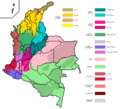In Spanish grammar, voseo (Spanish pronunciation: [boˈseo]) is the use of vos as a second-person singular pronoun, along with its associated verbal forms...
45 KB (3,958 words) - 01:37, 13 August 2024
Spanish language (section Voseo)
voseo. In a few dialects, all three pronouns are used, with usted, tú, and vos denoting respectively formality, familiarity, and intimacy. In voseo,...
227 KB (16,251 words) - 11:04, 17 August 2024
most of Argentina and Uruguay. It is the most prominent dialect to employ voseo (the use of vos in place of the pronoun tú, along with special accompanying...
33 KB (3,180 words) - 07:22, 31 July 2024
Chileans use the voseo and tuteo forms for the intimate second-person singular. Voseo is common in Chile, with both pronominal and verbal voseo being widely...
39 KB (4,052 words) - 05:00, 15 August 2024
vivís—'you live'); and verbal voseo with the Chilean verb endings (tú hablái, tú comís, etc.). "Full" voseo coexists with verbal voseo (tú comés) in Uruguay....
83 KB (9,837 words) - 02:22, 29 July 2024
Uruguayan Spanish (section Tuteo and voseo)
Montevideo and the whole southern region of the country exhibits use of the voseo form of address, with the pronoun vos instead of the tú form. In other areas...
11 KB (474 words) - 09:47, 15 August 2024
Central American Spanish (section Voseo)
Nicaragua adopted voseo as a symbol of nationalism. Educated Costa Ricans are also more comfortable using vos, and negative attitudes towards voseo have been...
17 KB (1,608 words) - 04:52, 15 August 2024
Paraguayan Spanish (section Voseo)
historical, and cultural proximity, as well as the sharing of features such as voseo, which is "the use of vos as a second-person singular pronoun." Paraguayan...
15 KB (1,555 words) - 09:41, 15 August 2024
Bolivian Spanish (section Tuteo and voseo)
[pweh]. For the second-person-singular pronoun and verb forms, the use of "voseo" is dominant. The use of diminutive -ingo and the augmentative -ango is...
11 KB (725 words) - 11:10, 15 August 2024
Salvadoran Spanish (section Voseo)
pronunciation and usage. El Salvador, like most of Central America, uses voseo Spanish as its written and spoken form, similar to that of Argentina. Vos...
14 KB (1,404 words) - 09:44, 15 August 2024
country is the largest Spanish-speaking society that universally employs voseo, the use of the pronoun vos instead of tú ("you"), which imposes the use...
250 KB (23,640 words) - 08:43, 15 August 2024
most other dialects. Characteristic regional usages of pronouns include voseo (using vos, the familiar singular "you", rather than the tú of other dialects)...
39 KB (4,339 words) - 07:41, 15 August 2024
Spanish grammar (section Voseo)
endings are -ás, -és, and -ís for -ar, -er, -ir verbs, respectively. (See "voseo".) In the tables of paradigms below, the (optional) subject pronouns appear...
68 KB (7,673 words) - 18:43, 5 June 2024
identity. Second-generation Salvadoran-Americans often engage in verbal voseo, using voseo-related verb forms alongside tú due to linguistic insecurity in contact...
82 KB (9,232 words) - 23:41, 12 August 2024
language. Uruguayan Spanish, as a variant of Rioplatense, employs both voseo and yeísmo (with [ʃ] or [ʒ]) and has a great influence of the Italian language...
160 KB (14,634 words) - 17:49, 15 August 2024
Spanish language as spoken in the country of Honduras in Central America. Voseo is routinely used in Honduras. Honduran Spanish, as a Central American variety...
5 KB (239 words) - 09:41, 15 August 2024
resembles the variety of Central American Spanish spoken in that country, where voseo is used. Meanwhile, the Treaty of Guadalupe Hidalgo led to a large number...
65 KB (6,729 words) - 08:22, 14 August 2024
which is known as Rioplatense Spanish, is distinguished by its use of voseo, yeísmo, and aspiration of s in various contexts. It is heavily influenced...
237 KB (21,604 words) - 18:50, 15 August 2024
are several sub-varieties of voseo within Latin America and many Latin American varieties do not have any form of voseo at all. The meaning of certain...
27 KB (2,572 words) - 08:30, 15 August 2024
speak Spanish that makes use of the medieval voseo pronoun equivalent to thou, making them the largest voseo Spanish speakers in the country. This is commonly...
74 KB (8,446 words) - 06:15, 14 August 2024
Spanish personal pronouns (section Voseo)
pronouns that have fallen out of use in Spanish. 1 Only in countries with voseo; Ladino has vos as the formal form, instead of usted. 2 Primarily in Spain;...
29 KB (3,506 words) - 15:16, 14 August 2024
the highest frequency, among Central American countries, of the use of voseo—use of the pronoun vos and its verb forms for the familiar second-person...
16 KB (1,445 words) - 09:22, 15 August 2024
person plural pronoun ustedes has supplanted the pronoun vosotros/vosotras. Voseo is now completely absent from insular Caribbean Spanish. Contemporary commentators...
14 KB (1,305 words) - 11:05, 15 August 2024
Saharan Salvadoran Standard Uruguayan Venezuelan Dialectology Seseo Yeísmo Voseo Leísmo Loísmo Interlanguages Llanito Jopara Judaeo-Spanish Portuñol Spanglish...
19 KB (1,928 words) - 08:18, 14 August 2024
apocope or syncope, which distinguishes it from the Chilean and Rioplatense voseo, respectively. Besides, the maracucho is characterized by the use of many...
4 KB (273 words) - 23:24, 5 July 2024
is also characterized by the lack of voseo, unlike many other Hispanic American countries. This is because voseo was primarily used by Spain's lower socioeconomic...
153 KB (16,098 words) - 23:20, 12 August 2024
the inhabitants. It is one of the last regions in Panama where Spanish voseo is the standard form for use. As is common in most of Panama, the province...
30 KB (2,430 words) - 00:47, 13 August 2024
informal. As in other regions of Central and South America, Salvadorans use voseo. This refers to the use of "vos" as the second person singular pronoun,...
186 KB (18,192 words) - 13:02, 17 August 2024
Spanish is the usage of the second person singular pronoun vos (called voseo) or usted instead of tú. Some native languages are still spoken in indigenous...
22 KB (2,032 words) - 05:09, 11 August 2024
However, in Zulia and some parts of Falcón and Trujillo, it is common to find voseo, the use of vos instead of tú. That phenomenon is present in many other...
47 KB (6,305 words) - 04:50, 15 August 2024




















